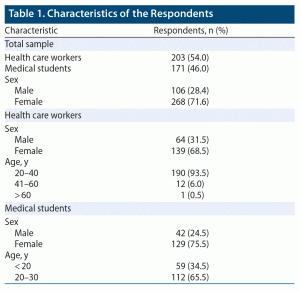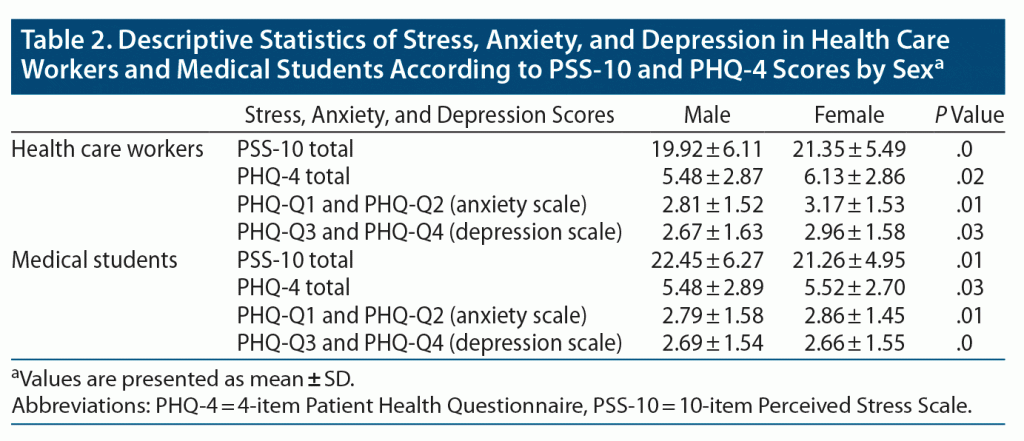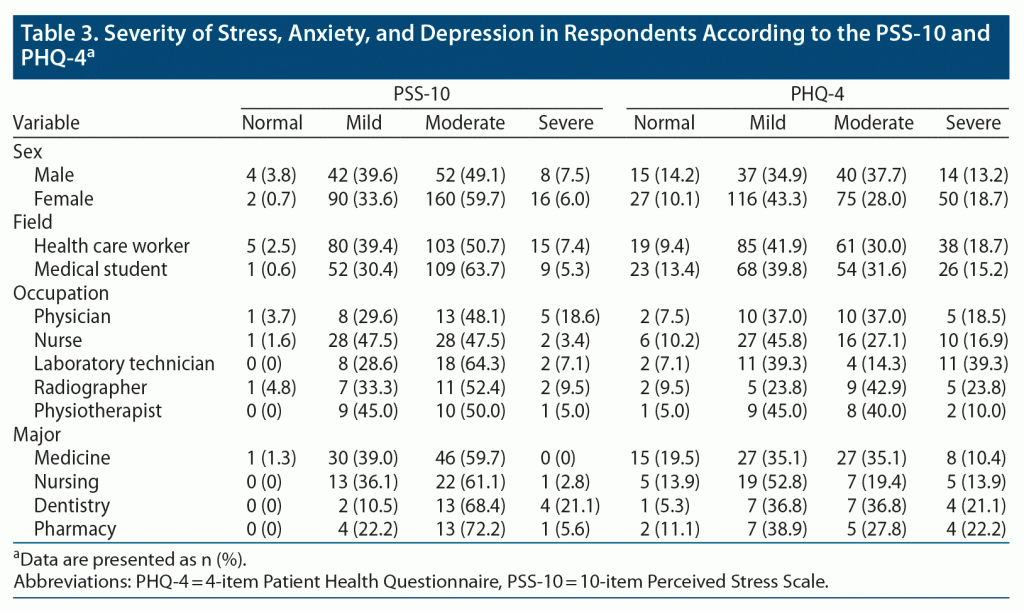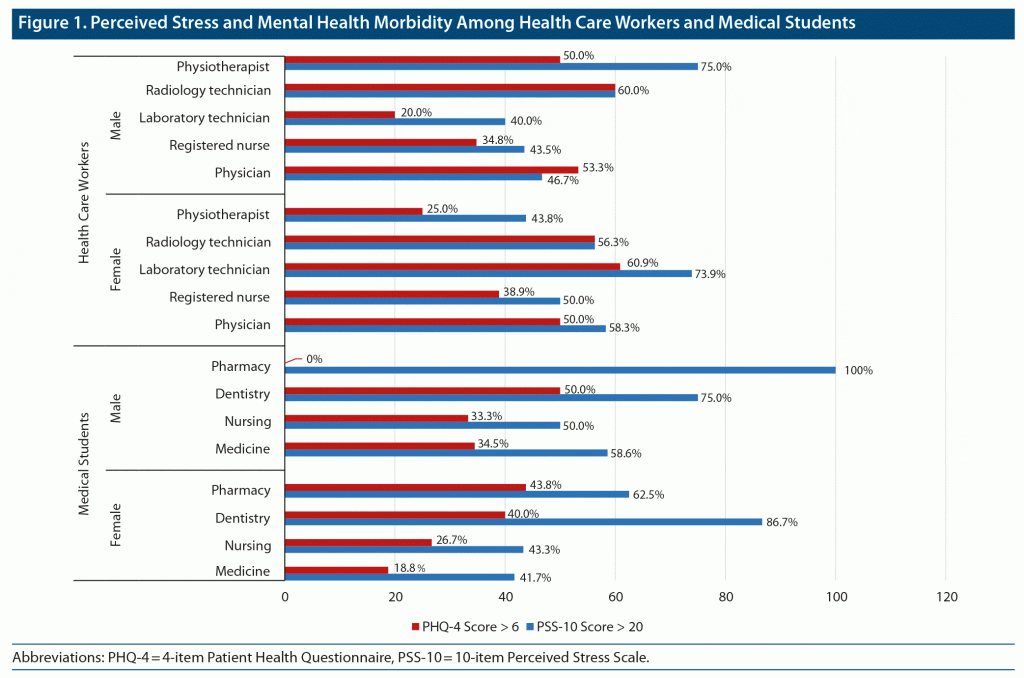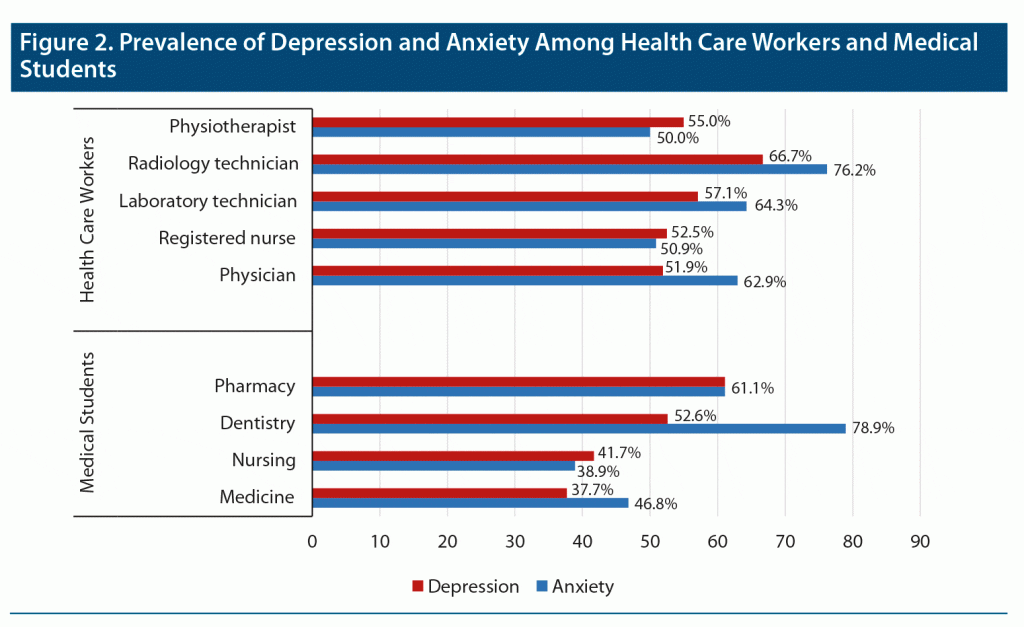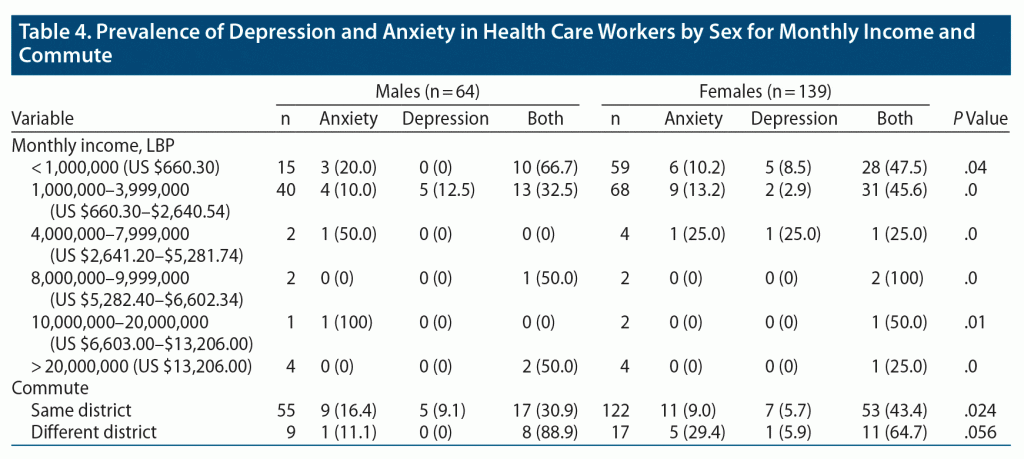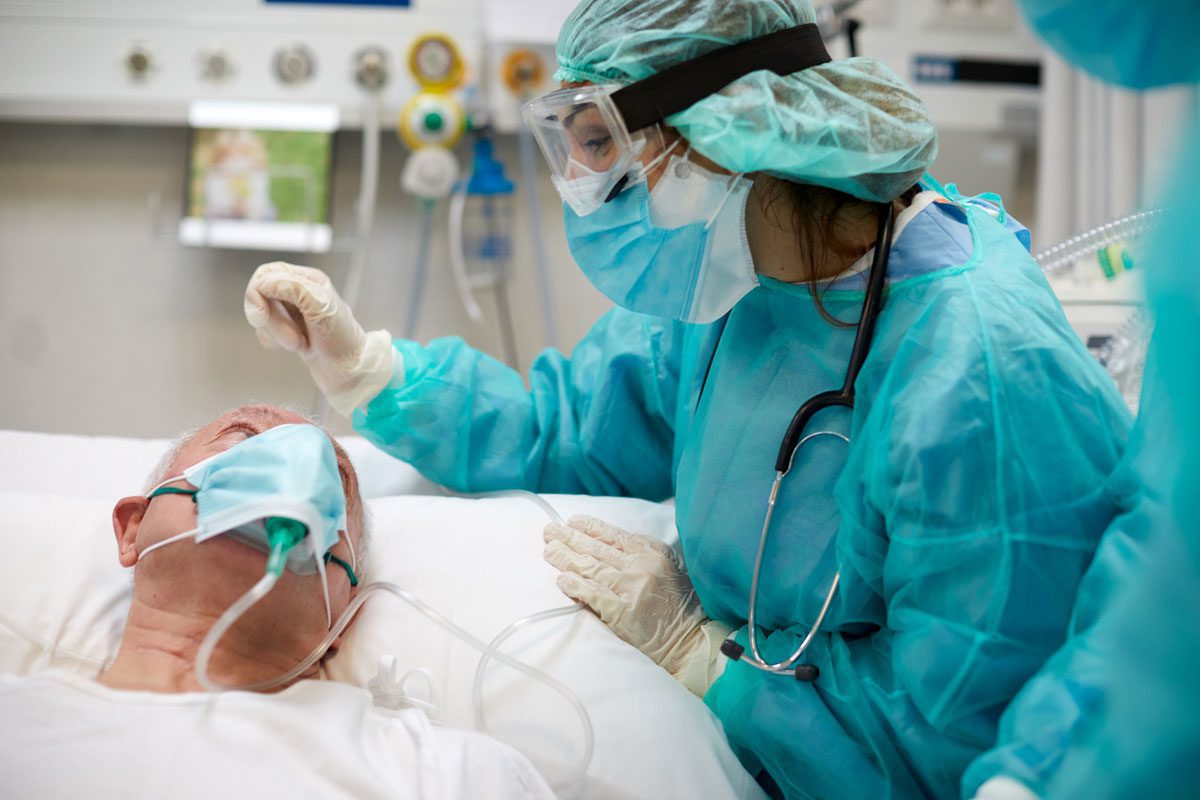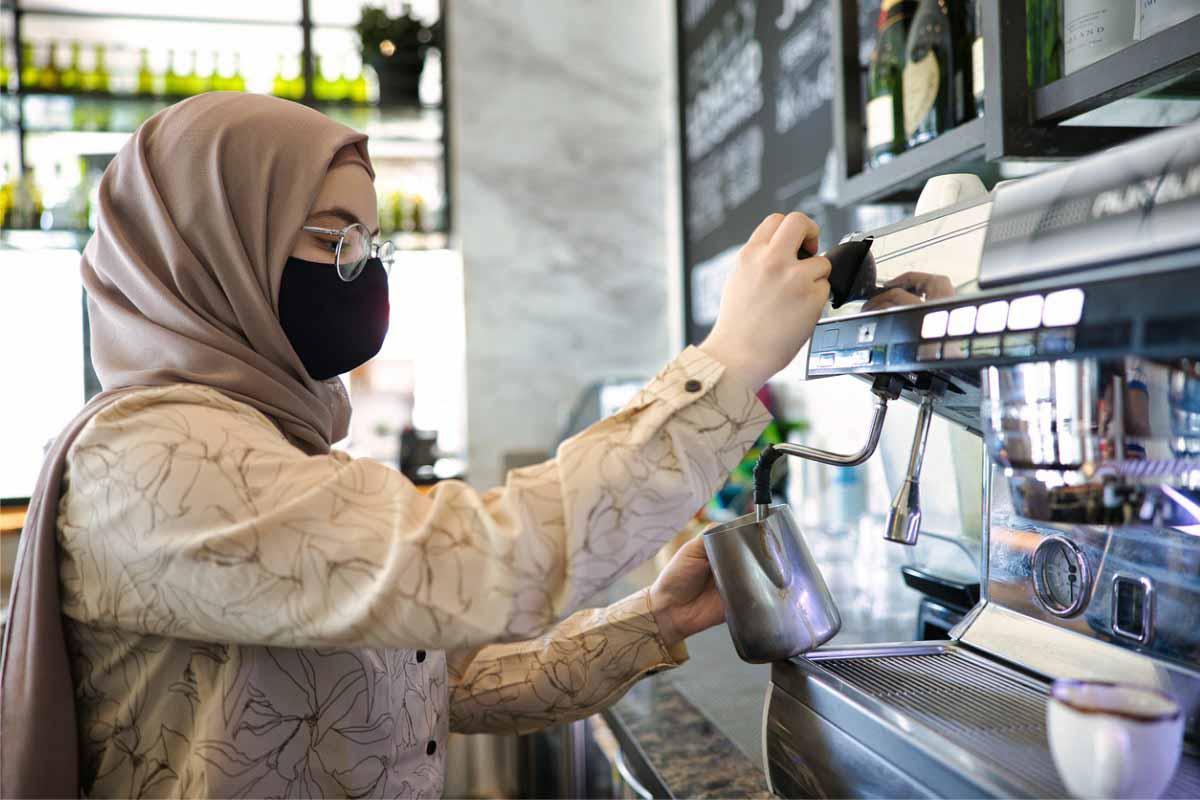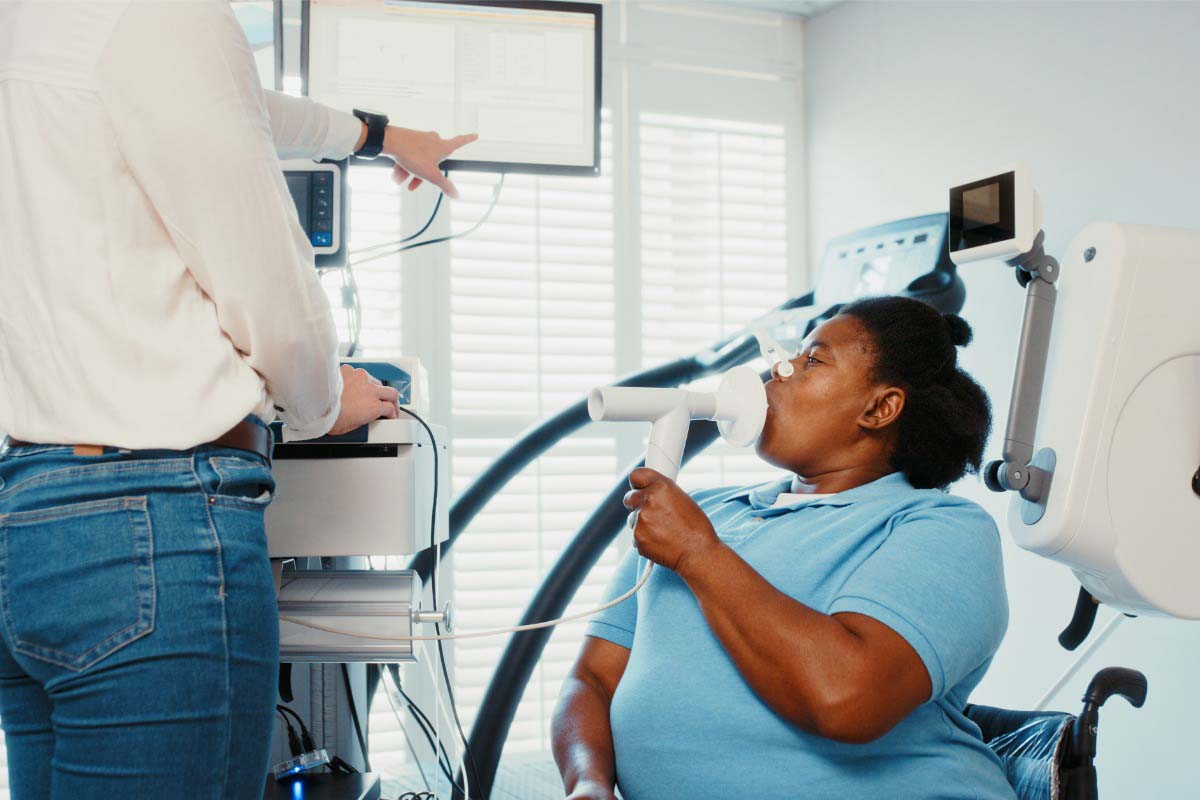ABSTRACT
Objective: To measure the mental health effects (perceived stress, anxiety, and depression) among health care workers and medical students in Lebanon during the coronavirus disease 2019 (COVID-19) pandemic and subsequent to the Beirut blast.
Methods: In this cross-sectional study, a self-administered online questionnaire was developed and distributed between late December 2020 and early February 2021 among health care workers and medical students via social media. The 10-item Perceived Stress Scale (PSS-10) and the 4-item Patient Health Questionnaire for Depression and Anxiety (PHQ-4) were administered. P values between variables were calculated using χ2 test.
Results: Overall, 98% of the respondents had a low PSS-10 score and 89% had a low PHQ-4 score. About 58.1% of health care workers and 69.0% of student respondents had moderate to severe stress on the PSS-10, and 48.7% and 46.8%, respectively, reported moderate to severe anxiety and depression on the PHQ-4. Prevalence of depression and anxiety was relatively higher among health care workers with monthly incomes < LBP 4 million (57.1%) and higher in women (39.9%) compared to men (17.2%). Furthermore, the prevalence of depression and anxiety was higher among health care workers traveling between different districts (63.0%) compared to those with residence and work location within the same district and was higher among females (65.4%) compared to males (34.6%).
Conclusions: The resilience of the Lebanese people as well as their ability to adapt in the face of trauma, tragedy, threats, or any significant source of stress is remarkable and seen in their everyday lives, especially subsequent to the Beirut blast. However, the psychological well-being and mental health of health care workers and medical students in Lebanon should be carefully surveilled and recorded during the COVID-19 pandemic, especially within the ongoing socioeconomic crisis.
Prim Care Companion CNS Disord 2021;23(4):21m02977
To cite: El Rassoul AEA, Razzak RA, Hashim HT. Mental health effects of COVID-19 within the socioeconomic crisis and after the Beirut blast among health care workers and medical students in Lebanon. Prim Care Companion CNS Disord. 2021;23(4):21m02977.
To share: https://doi.org/10.4088/PCC.21m02977
© Copyright 2021 Physicians Postgraduate Press, Inc.
aFaculty of Medical Sciences, Lebanese University, Hadath, Beirut, Lebanon
bUniversity of Baghdad, College of Medicine, Nasiriyah, Thi-Qar, Iraq
*Corresponding author: Hashim Talib Hashim, MBChB, University of Baghdad, College of Medicine, 400 St, 64001 Nasiriyah, Thi-Qar, Iraq ([email protected]).
Past events have undeniably shaped the way Lebanese citizens have maintained their livelihoods over the past few decades. On December 12, 2019, the first case of the novel strain of coronavirus disease 2019 (COVID-19) was identified in Wuhan City, China.1 On March 12, 2020, COVID-19 was declared a global pandemic by the World Health Organization (WHO) due to the exponential spread of the virus and the threat it imposed on the health care sector and economy worldwide.2 On February 21, 2020, the first case of COVID-19 was confirmed in Lebanon,3 and as of March 11, 2021, there have been 5,180 deaths out of the 405,391 confirmed cases.4
Lebanon was already amid a political and economic crisis when the pandemic spread across the Mediterranean. The crisis that the country was experiencing forced the Lebanese to commence a prodigious rebellion on October 17, 2019, catalyzing civil unrest and political and social turbulence. The impact of this unrest resulted in the immediate collapse of the banking system, pushing the country further on the edge of bankruptcy, and many businesses closed amid widespread unemployment.5 The central bank also limited US dollar withdrawals, causing an unforeseen crisis for the health care system, which could no longer afford to import medical supplies as the value of the Lira fell to record lows. The availability of many expensive and vital life-saving medications, including cancer drugs, has increasingly declined with the critical shortages of medicine and lack of transparency with regard to inflated drug prices.6 The aggressive containment imposed on the country early during the COVID-19 pandemic was essential to flattening the curve and establishing suitable health care capacity for the treatment of critical cases. However, half way through 2020 and with the reopening of the airport in July, a surge in the number of daily confirmed cases was observed and mostly attributed to the increased number of daily PCR (polymerase chain reaction) tests conducted.7 The country’s health care system was ailing and on the brink of collapse when a massive explosion at the Beirut Port on August 4, 2020 flattened much of the city, reaching across a 12-mile diameter. Four hospitals were heavily damaged and put largely out of commission, and, according to WHO, more than 20 primary care facilities serving approximately 160,000 patients were damaged or destroyed.8 Reports estimated that 300,000 people were immediately left homeless, over 5,000 were injured, and at least 154 were killed.7,9
With previous major infectious disease epidemics, including severe acute respiratory syndrome coronavirus 1,10 swine flu,11 Middle East respiratory syndrome coronavirus (MERS-CoV),12 avian influenza,13 and ebolavirus,14 research has shown significant mental health effects among the general public, health care workers, and disease survivors.15 During the COVID-19 pandemic, the stressful workplace conditions, lack of resources, and high risk of exposure to the virus put health care workers and their families at risk, and they were uncertain about their financial future given the country’s collective crises. At the same time, students were experiencing medical school during the pandemic, while also being uncertain about their futures after graduation.
Little is known, to our knowledge, about the impact of COVID-19 on the mental health of health care workers and medical students in Lebanon. Given the repercussions of the situation in Lebanon, it is vital to measure and analyze the psychological well-being of these different groups to develop measures and interventions to address ongoing mental health issues. This cross-sectional study measured the mental health effects of the COVID-19 pandemic (perceived stress, anxiety, and depression) on health care workers and medical students in Lebanon during the course of the socioeconomic crisis and subsequent to the Beirut blast.
METHODS
Study Setting and Design
A cross-sectional study was conducted between late December 2020 and early February 2021. In compliance with social distancing restrictions, a self-administered online questionnaire was developed in Google Forms and distributed among health care workers and medical students via social media (WhatsApp, Facebook, Instagram, and LinkedIn). All records were kept anonymous and confidential.
Study Instrument
The 10-item Perceived Stress Scale (PSS-10) and the Patient Health Questionnaire for Depression and Anxiety (PHQ-4) were administered. The PSS is a self-report questionnaire developed by Cohen et al16 to measure a person’s evaluation of stressful situations in the previous month of his/her life. The PSS is an easy-to-use, global stress measure that has been effectively tested in diverse settings and different languages and has been shown to have strong reliability and validity measures.17,18 It consists of negative elements, assessing the lack of control and negative affective reactions, as well as positive elements, measuring the degree of ability to cope with existing stressors. The PSS-10 is a short-form scale comprised of 10 items from the original PSS-14. The PSS-10 has also been shown to have strong reliability and validity,19–21 with psychometric properties found to be superior to those of the PSS-14.22,23 The PSS-10 score ranges from 0 to 40 (low to high), with higher scores equating to higher stress levels. In this study, the severity of stress level was categorized as normal (0–9), mild (10–19), moderate (20–29), and severe (30–40) based on PSS-10 scores. The PHQ-424 is a valid ultrabrief tool for detecting both anxiety and depressive disorders, and studies25,26 have confirmed its reliability and construct validity as a 4-item inventory in measuring such disorders in the general population. A score ≥ 3 on the anxiety subscale (questions 1 and 2) and depression subscale (questions 3 and 4) has been identified as a cutoff to identify the potential presence of anxiety and depression, respectively. The severity is categorized as normal (0–2), mild (3–5), moderate (6–8), and severe (9–12) based on the overall PHQ-4 scores.
Data Collection and Procedure
An online link to an electronic consent form and a basic sociodemographic information sheet was distributed. After providing consent, participants were redirected to a secure page to complete the questionnaire. The survey took approximately 3 minutes to complete.
Data Analysis
The data were analyzed with SPSS version 25. P values between variables were calculated using χ2.
RESULTS
A total of 374 respondents, 203 (54.0%) health care workers and 171 (46.0%) medical students, most of whom were women (71.6%) completed the questionnaire. Basic characteristics of the respondents are shown in Table 1. The majority (93.5%) of health care workers were in the age group 20–40 years, and 68.5% were women including nurses (29.0%), laboratory technicians (13.8%), physicians (13.0%), radiographers (10.3%), physiotherapists (10.0%), dieticians (9.4%), pharmacists (7.0%), dentists (3.5%), psychologists and psychosocial counselors (2.0%), radiotherapists (1.0%), and optometrists (1.0%). The majority of student respondents were in the age group 20–30 years (65.5%), and 75.5% were women with majors in medicine (45.0%), nursing (21.0%), dentistry (11.1%), pharmacy (10.5%), laboratory sciences (3.5%), radiologic sciences (3.0%), nutrition (3.0%), physiotherapy (2.4%), and optometry (0.5%).
The majority of health care workers were residents in the districts of Beirut (32.0%) and West Beqaa (30.5%), and most work locations were centered there as well (Beirut: 42.0%, West Beqaa: 29.5%). Most respondents (75.4%) were employed at a single institution, with only 9.4% working at ≥ 3 places. About 52.7% had monthly salaries during the ongoing crises between LBP 1,000,000–4,000,000 (US $660.30–2,641.20), and almost 4.4% earned over LBP 20 million (US $13,206.00) per month.
Mean PSS-10 and PHQ-4 scores of the respondents by sex and field are reported in Table 2. Among male and female health care workers, the mean (SD) PSS-10 scores were 19.92 (6.11) and 21.35 (5.49), respectively, while the PHQ-4 scores were 5.48 (2.87) and 6.13 (2.86), respectively. Among male and female students, the PSS-10 scores were 22.45 (6.27) and 21.26 (4.95), respectively, while the PHQ-4 scores were 5.48 (2.89) and 5.52 (2.70), respectively. The difference in the mean values of the PSS-10 and PHQ-4 among male and female respondents was statistically significant (P = .02), with significant sex influence in both PSS-10 and PHQ-4 scores.
Overall, 98% of the respondents had a low PSS-10 score, and 89% had a low PHQ-4 score. About 58.1% of health care workers and 69.0% of student respondents had moderate to severe stress on the PSS-10, and 48.7% and 46.8%, respectively, reported moderate to severe anxiety and depression on the PHQ-4 (Table 3). Severity levels of perceived stress, anxiety, and depression among health care workers and students are presented in Figure 1 for occupations and majors with respondent percentages ≥ 10%.
Among health care workers, elevated stress level and mood disorder (PSS-10 and PHQ-4, respectively) were consistently higher among female laboratory technicians (73.9% and 60.9%) and nurses (50.0% and 38.9%) compared to male laboratory technicians (40.0% and 20.0%) and nurses (43.5% and 34.8%). These levels were also higher among male physiotherapists (75.0% and 50.0%) and radiographers (60.0% and 60.0%) compared to female physiotherapists (43.8% and 25.0%) and radiographers (56.3% and 56.3%).
Elevated stress level was relatively higher among female physicians (58.3%) compared to males (46.7%), and elevated mood disorder was relatively higher among male physicians (53.3%) compared to females (50.0%). Among students, elevated stress level and mood disorder (PSS-10 and PHQ-4, respectively) were consistently higher among males in nursing (50.0% and 33.3%) and medicine (58.6% and 34.5%) compared to females in nursing (43.3% and 26.7%) and medicine (41.7% and 18.8%). Elevated stress level was higher in females in dentistry (86.7%) compared to males (75.0% of 2 respondents) and in males in pharmacy (100% of 2 respondents) compared to females (62.5%). Elevated mood disorder was relatively higher in females in pharmacy (43.8%) compared to males (0% of 2 respondents) and in males in dentistry (50.0% of 2 respondents) compared to females (40.0%).
The prevalence of anxiety and depression among physicians, nurses, laboratory technicians, radiographers, and physiotherapists was ≥ 50%. Moreover, this prevalence was higher in radiographers compared to other health care occupations and in dentistry and pharmacy students compared to those in medicine and nursing as illustrated in Figure 2.
Prevalence of depression and anxiety was relatively higher among health care workers with monthly incomes < LBP 4 million (US < $2,641.20) (57.1%) and was reported higher in females (39.9%) compared to males (17.2%). The difference in the prevalence of anxiety and depression between male and female health care workers in relation to monthly incomes was statistically significant (P = .01). Furthermore, prevalence of depression and anxiety was reported to be higher among health care workers traveling between different districts (63.0%) compared to those with residence and work location within the same district and was reported to be higher in females (65.4%) compared to males (34.6%) (Table 4). For additional data that were extracted from the study, please see the Supplementary Material.
DISCUSSION
There is a high prevalence of mental health morbidity in the form of stress, anxiety, and depression among health care workers and students in Lebanon. Health care workers are the first line of defense against COVID-19 and are in direct contact with infected patients. Health care facilities, hospitals, and medical centers have been working tirelessly since the Beirut blast to keep up with the increased number of new COVID-19–positive cases, the subsequent increased demands for medical equipment and medication, and the lack of intensive care unit beds. Health care workers, especially physicians, normally experience notable mental health issues such as emotional fatigue and burnout.26 Studies have also associated physician burnout with depression,27–29 a 25% increased probability of alcohol abuse or dependence,30 and twice the risk of suicidal ideation.31,32 This increased risk of suicidal ideation is critical considering that the suicide rate among male physicians is 40% higher than that of males in the general population and 130% higher among female physicians than females in the general population.26,33
Since the beginning of the COVID-19 pandemic, some studies have examined the virus’s impact on mental health and psychological distress. Studies34–36 in China found that nurses, women, frontline health care workers, and those working in Wuhan, China reported more severe prevalence of mental health symptoms and overall psychological problems than other health care workers. Our study results are similar, including the finding of relatively high levels of mental health impact on women and nurses. This strong sex difference in levels can be related to physiologic or psychosocial factors that require further analysis. Moreover, Gao et al13 found that during the SARS outbreak, more women than men sought counseling for emotional issues.
University students have been shown to be distinctively susceptible to developing stress disorders and depression, which are expected to increase due to COVID-19 and the psychological challenges of digital learning.37 These adopted online learning strategies through online platforms have given rise to depression and anxiety disorders among undergraduate university students, in whom a significant correlation between student satisfaction and prevalence of depression, anxiety, and stress has been shown.38 Moreover, Lebanon’s economy and financial barriers can also hinder student access to technologies required for online learning.39 Lebanese students are facing a unique reality wherein the economic, political, and health circumstances are posing exhausting challenges to their social stability and professional development. A study by Fawaz and Samaha38 indicated that the sudden shift to exclusive online learning methods decreased the students’ satisfaction with their learning experience. Our results were similar and showed that 39.8% of students had mild anxiety and depression levels, 31.6% had moderate levels, and 15.2% had severe levels. A study by Huang et al36 found that college students often develop immature or negative coping strategies when having to face public health emergency pressures. Nursing students during an epidemic have been shown to experience levels of psychological stress and concern regarding their future career, with nurses reporting stronger anxiety and fear due to their working environment and discomfort resulting from the need for physical protection and transmission prevention.40
Public emergencies, such as those that Lebanon citizens have been enduring since the 2019 rebellion, can affect the psychological well-being of the population in general and health care workers and students in particular, reflected in the form of stress, anxiety, and depression. The COVID-19 pandemic appeared suddenly and demanded immediate attention, which further exacerbated stress levels to a prodigious extent as evidenced by our data. This stress among health care workers has been accentuated by a lack of necessary equipment and medications and the surge of patients that overwhelmed the health care infrastructure even prior to the Beirut blast. Health care workers who were already suffering from psychological burnout due to the COVID-19 pandemic were also among those who lost their lives or were severely injured by the Beirut blast,41 and according to the Lebanese syndicate of physicians,42 over 2,000 doctors’ offices and clinics were damaged due to the explosion. Health care workers are compelled to deal with heavy psychological stress while putting their own health and that of their families at risk. Khalid et al43 reported the prevalence of anxiety among health care staff at a tertiary care hospital in Jeddah, Saudi Arabia during the MERS-CoV epidemic relative to the fear of infection. The study43 highlighted that the clash between job responsibilities and the health of medical workers’ families was the main source of stress. Furthermore, Fawaz and Samaha44 found that while working during the COVID-19 pandemic and being quarantined after exposure, Lebanese health care workers started to show manifestations of severe stress, anger, and frustration related to the fear of contracting the virus and infecting their families. Duan and Zhu45 found a similar prevalence of psychiatric disorders in China during the outbreak, and a recent study by Xu and Zhang46 reported negative emotional outcomes of anxiety, depression, and fear among nurses due to COVID-19 and quarantine. Similarly, our results were consistent with a study from Toronto, Canada by Nickell et al,47 which found mental distress among nearly 20% of health care workers after SARS, with a significant prevalence among nurses.
The COVID-19 quarantine and strict restrictions imposed by the Lebanese government in the period between the Beirut blast and Christmas holiday in 2020 have been psychologically challenging for the Lebanese population, at times worsening the mental health of health care workers and creating economic instability. Our results point to higher levels of stress among health care workers with monthly incomes < LBP 4 million (US $660.30–2,641.20) (57.1%), which is consistent with findings of Sareen et al48 that showed an association between low levels of household income and increased risk for incident mental disorders, several lifetime mental disorders, and suicide attempts. Moreover, a decrease in income was also associated with increased risk for mood disorders and substance use disorders. However, decreased income was not found to be associated with incident anxiety disorders.48 Social causality has shown that distress, stress, and reduced capacity to cope in relation to low income increase the risk of the development of mental illness, which necessitates targeted interventions to treat and prevent mental illness in this low-income sector of the population. In a meta-analysis of more than 50 cross-national epidemiologic studies focused on the relationship between socioeconomic status and depression, Lorant et al49 concluded that individuals with low income were at increased odds of depression compared with those in the higher income categories. Comparably, a systematic review by Fryers et al50 also found that lower socioeconomic status is correlated to an increased likelihood of mood, anxiety, and substance use disorders.
We also found a higher prevalence of depression and anxiety among health care workers traveling between different districts that was higher among women (43.3%) than men (19.7%). Commuting is a daily routine that may be viewed negatively and induce stress, particularly related to factors such as distance, duration, slow speed, and traffic jams. The results of our study are consistent with previous research demonstrating that stressful long commutes to work affect both men and women. However, the long-term effect applies only for women. Feng and Boyle51 showed that those with commutes > 1 hour reported more stress than those who had commutes of half an hour or less. Moreover, similar results were found by Evans et al52 relating the long duration of commuting to higher levels of stress, but no sex difference was associated with the findings.
There are some limitations to our study that must be considered. This was a cross-sectional study carried out during a rapidly changing situation in Lebanon. Moreover, it was an internet-based survey, and the anonymous nature of the responses limited the ability to verify the veracity of the respondents. The sample size and the relatively skewed representation can be considered another limitation as well. However, despite these limitations, our study provides insight into the degree of mental health morbidity among health care workers and medical students and paves the way for studies with increased sample sizes and more specificity to further elaborate these findings and yield a more accurate picture. Our results point to the urgent need for increased attention and intervention during the critical situations that Lebanon is currently experiencing.
CONCLUSION
In summary, the resilience of the Lebanese people and their ability to adapt in the face of trauma, tragedy, threats, or any significant source of stress is clearly remarkable and discerned in their everyday lives, especially subsequent to the Beirut blast. However, this study is a notable addition to the literature that clearly suggests that the psychological well-being and mental health of health care workers and medical students should be carefully surveilled and recorded during the pandemic and especially within the ongoing socioeconomic crisis. Targeted interventions should be adapted, and hospitals, medical centers, and universities should endorse psychological support approaches. Moreover, these efforts may need to be especially focused on women, as this population reported relatively higher stress, anxiety, and depression scores than men. In conclusion, it is essential that Lebanese health care workers are provided mental health services, and the Ministry of Health and Ministry of Education should be supplied adequate resources to educate people about mental health issues.
Submitted: March 26, 2021; accepted April 29, 2021.
Published online: July 15, 2021.
Potential conflicts of interest: None.
Funding/support: None.
Supplementary material: See accompanying pages.
Clinical Points
- The resilience of the Lebanese people as well as their ability to adapt in the face of trauma, tragedy, threats, or any significant source of stress is remarkable and seen in their everyday lives, especially subsequent to the Beirut blast.
- The psychological well-being and mental health of health care workers and medical students in Lebanon should be carefully surveilled and recorded during the COVID-19 pandemic and especially within the ongoing socioeconomic crisis.
References (52)

- Dhama K, Khan S, Tiwari R, et al. Coronavirus disease 2019-COVID-19. Clin Microbiol Rev. 2020;33(4):e00028–e20. PubMed CrossRef
- Timeline: WHO's COVID-19 Response. June 16, 2021. https://www.who.int/emergencies/diseases/novel-coronavirus-2019/interactive-timeline#!
- Lebanon confirms first case of COVID-19, two more suspected. CAN website. Accessed March 11, 2021. https://www.channelnewsasia.com/news/world/covid19-coronavirus-lebanon-confirms-first-case-12458988
- WHO Health Emergency Dashboard. WHO website. Accessed March 11, 2021. https://covid19.who.int/region/emro/country/lb
- Nuwayhid I, Zurayk H. The political determinants of health and wellbeing in the Lebanese uprising. Lancet. 2019;394(10213):1974–1975. PubMed CrossRef
- NPR Cookie Consent and Choices. Npr.org website. Accessed March 11, 2021. https://www.npr.org/2020/02/09/800410394/amid-lebanons-economic-crisis-the-countrys-health-care-system-is-ailing
- Ghandour D, Ghandour D. The surge of COVID-19 cases in Lebanon - Executive Magazine. Executive Magazine website. Accessed March 11, 2021. https://www.executive-magazine.com/economics-policy/the-surge-of-covid-19-cases-in-lebanon
- The Beirut Blast Left Lebanon’s Health System Badly Shaken. Direct Relief website. Accessed March 11 2021. https://www.directrelief.org/2020/10/the-beirut-blast-left-lebanons-health-system-badly-shaken/
- Humanitarian Aid Organization for Children. Save the Children website. Accessed March 11, 2021. https://www.savethechildren.org/
- Peiris JS, Yuen KY, Osterhaus AD, et al. The severe acute respiratory syndrome. N Engl J Med. 2003;349(25):2431–2441. PubMed CrossRef
- Trifonov V, Khiabanian H, Rabadan R. Geographic dependence, surveillance, and origins of the 2009 influenza A (H1N1) virus. N Engl J Med. 2009;361(2):115–119. PubMed CrossRef
- Zaki AM, van Boheemen S, Bestebroer TM, et al. Isolation of a novel coronavirus from a man with pneumonia in Saudi Arabia. N Engl J Med. 2012;367(19):1814–1820. PubMed CrossRef
- Gao R, Cao B, Hu Y, et al. Human infection with a novel avian-origin influenza A (H7N9) virus. N Engl J Med. 2013;368(20):1888–1897. PubMed CrossRef
- Baseler L, Chertow DS, Johnson KM, et al. The pathogenesis of ebola virus disease. Annu Rev Pathol. 2017;12(1):387–418. PubMed CrossRef
- Zürcher SJ, Kerksieck P, Adamus C, et al. Prevalence of mental health problems during virus epidemics in the general public, health care workers and survivors: a rapid review of the evidence. Front Public Health. 2020;8:560389. PubMed CrossRef
- Cohen S, Kamarck T, Mermelstein R. A global measure of perceived stress. J Health Soc Behav. 1983;24(4):385–396. PubMed CrossRef
- Ribeiro Santiago PH, Nielsen T, Smithers LG, et al. Measuring stress in Australia: validation of the Perceived Stress Scale (PSS-14) in a national sample. Health Qual Life Outcomes. 2020;18(1):100. PubMed CrossRef
- Mimura C, Griffiths P. A Japanese version of the Perceived Stress Scale: translation and preliminary test. Int J Nurs Stud. 2004;41(4):379–385. PubMed CrossRef
- Baik SH, Fox RS, Mills SD, et al. Reliability and validity of the Perceived Stress Scale-10 in Hispanic Americans with English or Spanish language preference. J Health Psychol. 2019;24(5):628–639. PubMed CrossRef
- Huang F, Wang H, Wang Z, et al. Psychometric properties of the perceived stress scale in a community sample of Chinese. BMC Psychiatry. 2020;20(1):130. PubMed CrossRef
- Sun Y, Gao L, Kan Y, et al. The Perceived Stress Scale-10 (PSS-10) is reliable and has construct validity in Chinese patients with systemic lupus erythematosus. Lupus. 2019;28(2):149–155. PubMed CrossRef
- Lee EH. Review of the psychometric evidence of the Perceived Stress Scale. Asian Nurs Res (Korean Soc Nurs Sci). 2012;6(4):121–127. PubMed CrossRef
- Liu X, Zhao Y, Li J, et al. Factor structure of the 10-item Perceived Stress Scale and measurement invariance across genders among Chinese adolescents. Front Psychol. 2020;11:537. PubMed CrossRef
- Kroenke K, Spitzer RL, Williams JBW, et al. An ultra-brief screening scale for anxiety and depression: the PHQ-4. Psychosomatics. 2009;50(6):613–621. PubMed
- Löwe B, Wahl I, Rose M, et al. A 4-item measure of depression and anxiety: validation and standardization of the Patient Health Questionnaire-4 (PHQ-4) in the general population. J Affect Disord. 2010;122(1-2):86–95. PubMed CrossRef
- West CP, Dyrbye LN, Shanafelt TD. Physician burnout: contributors, consequences and solutions. (Review) J Intern Med. 2018;283(6):516–529. PubMed CrossRef
- Bianchi R, Schonfeld IS, Laurent E. Burnout-depression overlap: a review. Clin Psychol Rev. 2015;36:28–41. PubMed CrossRef
- Shanafelt TD, Sloan JA, Habermann TM. The well-being of physicians. Am J Med. 2003;114(6):513–519. PubMed CrossRef
- Asai M, Morita T, Akechi T, et al. Burnout and psychiatric morbidity among physicians engaged in end-of-life care for cancer patients: a cross-sectional nationwide survey in Japan. Psychooncology. 2007;16(5):421–428. PubMed CrossRef
- Oreskovich MR, Kaups KL, Balch CM, et al. Prevalence of alcohol use disorders among American surgeons. Arch Surg. 2012;147(2):168–174. PubMed CrossRef
- Shanafelt TD, Balch CM, Dyrbye L, et al. Special report: suicidal ideation among American surgeons. Arch Surg. 2011;146(1):54–62. PubMed CrossRef
- van der Heijden F, Dillingh G, Bakker A, et al. Suicidal thoughts among medical residents with burnout. Arch Suicide Res. 2008;12(4):344–346. PubMed CrossRef
- Center C, Davis M, Detre T, et al. Confronting depression and suicide in physicians: a consensus statement. JAMA. 2003;289(23):3161–3166. PubMed CrossRef
- Lai J, Ma S, Wang Y, et al. Factors associated with mental health outcomes among health care workers exposed to coronavirus disease 2019. JAMA Netw Open. 2020;3(3):e203976. PubMed CrossRef
- Que J, Shi L, Deng J, et al. Psychological impact of the COVID-19 pandemic on healthcare workers: a cross-sectional study in China. Gen Psychiatr. 2020;33(3):e100259. PubMed CrossRef
- Huang L, Lei W, Xu F, et al. Emotional responses and coping strategies in nurses and nursing students during Covid-19 outbreak: a comparative study. PLoS One. 2020;15(8):e0237303. PubMed CrossRef
- Othman N, Ahmad F, El Morr C, et al. Perceived impact of contextual determinants on depression, anxiety and stress: a survey with university students. Int J Ment Health Syst. 2019;13(1):17. PubMed CrossRef
- Fawaz M, Samaha A. E-learning: Depression, anxiety, and stress symptomatology among Lebanese university students during COVID-19 quarantine. Nurs Forum. 2021;56(1):52–57. PubMed CrossRef
- Zeng Y, Wang G, Xie C, et al. Prevalence and correlates of depression, anxiety and symptoms of stress in vocational college nursing students from Sichuan, China: a cross-sectional study. Psychol Health Med. 2019;24(7):798–811. PubMed CrossRef
- Hashim HT, Uakkas S, Reda A, et al. Beirut explosion effects on COVID-19 situation in Lebanon. Disaster Med Public Health Prep. 2021;16:1–2. PubMed CrossRef
- Farha L, Abi Jaoude J. Lebanese healthcare system: how will the aftermath look? Cureus. 2020;12(9):e10270. PubMed
- El Sayed MJ. Beirut ammonium nitrate explosion: a man-made disaster in times of the COVID-19 pandemic. Disaster Med Public Health Prep. 2020;18:1–5. PubMed CrossRef
- Khalid I, Khalid TJ, Qabajah MR, et al. Healthcare workers emotions, perceived stressors and coping strategies during a MERS-CoV outbreak. Clin Med Res. 2016;14(1):7–14. PubMed CrossRef
- Fawaz M, Samaha A. The psychosocial effects of being quarantined following exposure to COVID-19: a qualitative study of Lebanese health care workers. Int J Soc Psychiatry. 2020;66(6):560–565. PubMed CrossRef
- Duan L, Zhu G. Psychological interventions for people affected by the COVID-19 epidemic. Lancet Psychiatry. 2020;7(4):300–302. PubMed CrossRef
- Xu MC, Zhang Y. Psychological survey of the first-line clinical front-line support nurses to combat new coronavirus-infected pneumonia. Nursing Research of China. 2020;34(3):368–370.
- Nickell LA, Crighton EJ, Tracy CS, et al. Psychosocial effects of SARS on hospital staff: survey of a large tertiary care institution. CMAJ. 2004;170(5):793–798. PubMed CrossRef
- Sareen J, Afifi TO, McMillan KA, et al. Relationship between household income and mental disorders: findings from a population-based longitudinal study. Arch Gen Psychiatry. 2011;68(4):419–427. PubMed CrossRef
- Lorant V, Deliège D, Eaton W, et al. Socioeconomic inequalities in depression: a meta-analysis. Am J Epidemiol. 2003;157(2):98–112. PubMed CrossRef
- Fryers T, Melzer D, Jenkins R. Social inequalities and the common mental disorders: a systematic review of the evidence. Soc Psychiatry Psychiatr Epidemiol. 2003;38(5):229–237. PubMed CrossRef
- Feng Z, Boyle P. Do long journeys to work have adverse effects on mental health? Environ Behav. 2013;46(5):609–625. CrossRef
- Evans GW, Wener RE, Phillips D. The morning rush hour: predictability and commuter stress. Environ Behav. 2002;34(4):521–530. CrossRef
Please sign in or purchase this PDF for $40.

